Ubiquiti makes great access points with their Unifi line. They have the best value for money in my opinion, so I was really waiting for their new WiFi 6 Access Points. With the Unifi 6 Lite and the Unifi 6 LR now generally available, is it a good time to take a closer look.
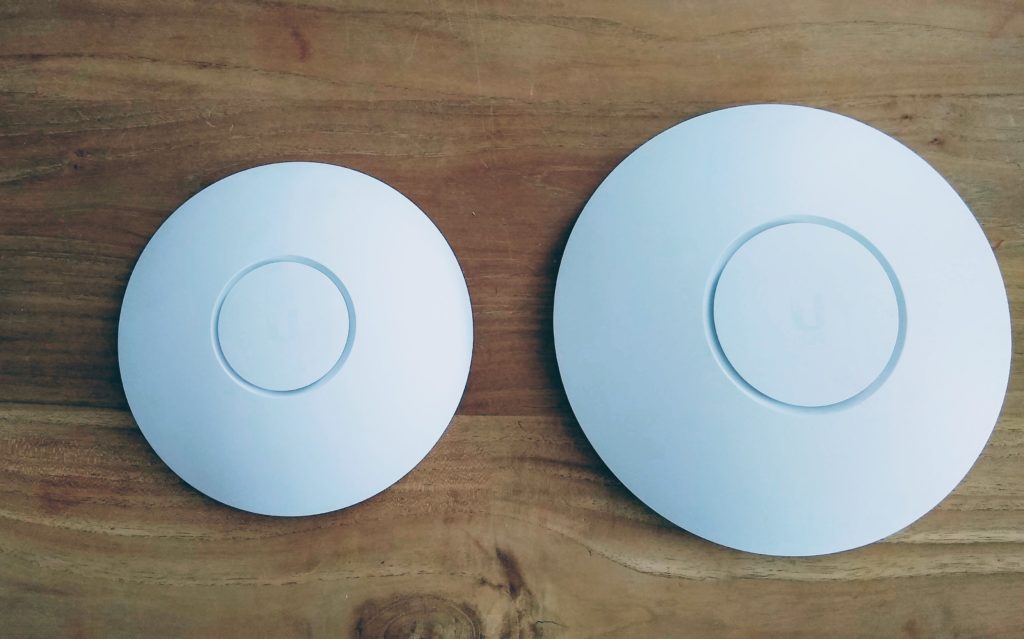
In my home network, I was already using the normal Unifi Lite and LR model, so in this article, we will compare the old with the new models. I have done different tests to compare the speed and signal strength of the access points, in different scenarios.
WiFi 6 Improvements
Before we take a look at the new Ubiquiti WiFi 6 access points, lets first briefly recap the general improvements of the new WiFi 6 standard.
The new wireless network standard, WiFi 6 (802.1ax), was released in 2019. It has a lot of improvements, including efficiency, speed, security (WPA3), and most importantly, much better performance in dense areas.
One of the advantages of WiFi 6 is that it allows devices to use the same WiFi channels by breaking up the channel into smaller groups (Resource Units). This way more devices can communicate at the same time. Other improvements are MU-MIMO in both downlink and uplink direction, Target Wait Time, Dynamic fragmentation, and more.
All these improvements really benefit the performance and battery lifetime of your devices. Keep in mind though that your clients need to support WiFi 6 to fully benefit from these new features.
UniFi 6 lite vs UniFi 6 Long Range
The Unifi 6 Lite and the U6 LR are the first WiFi 6 access point from Ubiquiti. And even though they are both WiFi 6 access points, they are completely different when it comes to size, specifications, performance, and usability.
I have created an overview of all Unifi Access Points, including new upcoming WiFi 6 models. Make sure you check it out.
Let’s first start with the size of the new access points. The new lite access point, the U6 Lite, has now the same size as the nanoHD. This means that you can use the covers from the nanoHD on the new U6 lite which is great when it comes to placing the access point insight.
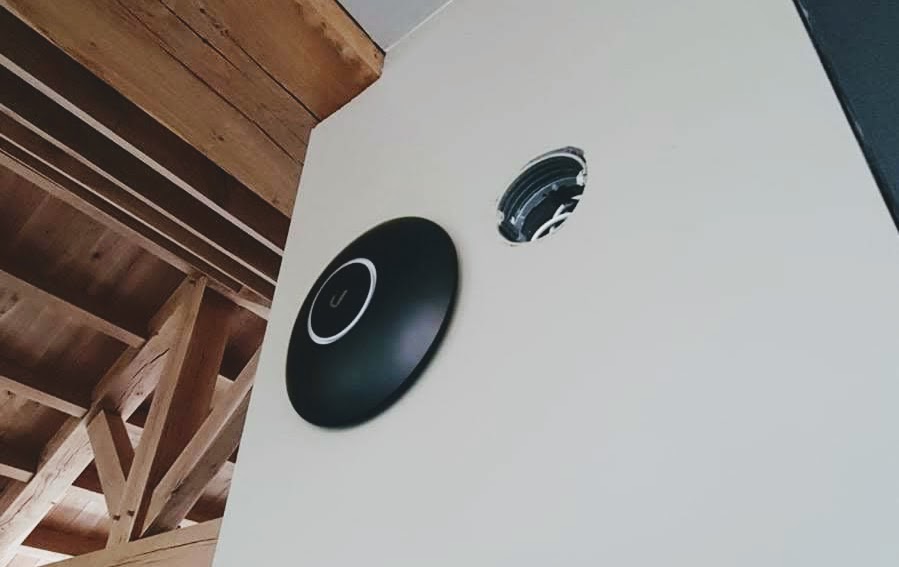
The size of the U6 LR on the other hand is increased a lot compared to the old model. It’s the same size as the old Unifi HD access point. The new long-range access point is splash and dust resistant (IP54 rated), which means you can place it semi-outdoors under a porch for example.
Tip
To control your Unifi Access Points you can also use a hosted Unifi Controller. This way you don’t need to buy additional hardware and worry about keeping your network up-to-date.
What I really like about both new access points is that you can still use the old wall/ceiling mount on the new access points. Even though the U6 LR comes with a new and bigger mounting bracket, you could still use the old bracket. This makes replacing your old access points with the new WiFi 6 models really easy.
But I have to say, the new mounting bracket of the Unifi 6 LR is easier to use and mount. It comes with pre-drilled holes for pretty much any situation (wall, ceiling, EU socket, Outlet Box (US), Junction box (US)), a nice set of screws and plugs, and attaching the access point itself is a lot easier.
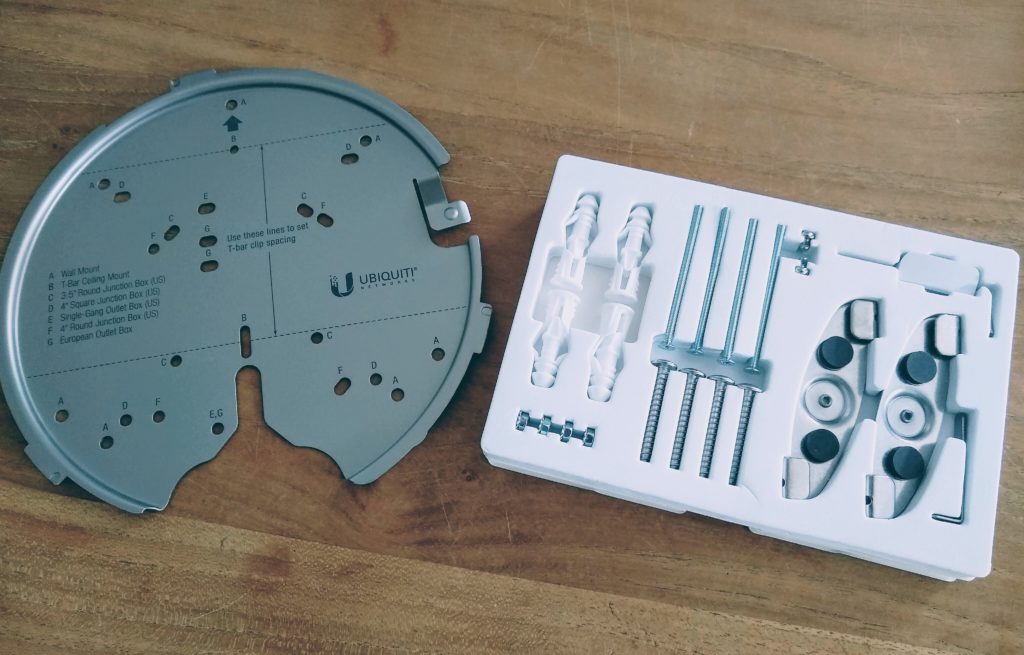
U6 Lite and U6 LR Specifications
If we look at the specifications of the new access points then we can understand why the Unifi 6 LR is so much bigger. It has twice the amount of RAM, faster CPU, Bluetooth (for management), 4×4 spatial streams, addressable RGB led ring, and antennas with a higher gain and transmit power.
The more sensitive antennas are also the trademark of the long-range model. It’s capable of covering a large area and also better at picking up the signal of the weaker mobile devices (which have a low transmit power compared to the access points).
| Unifi Access Points Comparison | ||||||||
U6 Lite 
|
U6 LR 
|
|||||||
| MSRP Price | $99.00 | $179.00 | ||||||
| Wifi 6 | ||||||||
| CPU | 880 MHz MIPS 1004 KEc | Dual-Core® Cortex® A53 at 1.35 GHz | ||||||
| Memory | 256 MB | 512 MB | ||||||
| 2.4 Ghz Speed | 300 Mbps | 600 Mbps | ||||||
| 5 Ghz Speed | 1200 Mbps | 2400 Mbps | ||||||
| Concurrent Clients | 300+ | 300+ | ||||||
| MIMO | 2×2 | 4×4 | ||||||
| Max TX Power 2.4Ghz | 23 dBm | 26 dBm | ||||||
| Max TX Power 5Ghz | 23 dBm | 26 dBm | ||||||
| Antenna Gain 2.4Ghz | 2.8 dBi | 4 dBi | ||||||
| Antenna Gain 5Ghz | 3 dBi | 5.5 dBi | ||||||
| MU-MIMO | ||||||||
| Outdoor | Semi-outdoor | |||||||
| Covers | ||||||||
| Dimensions | Ø160 X 32.65 mm | Ø220 X 48 mm | ||||||
| Weight | 300 gram | 800 gram | ||||||
| Power Method | 802.3af PoE | 802.3at PoE+ | ||||||
| Buy now | Buy now | |||||||
Good the know is that WiFi 6 is only supported on the 5GHz band on both models. We see this also with other manufactures, that they only upgrade the 5GHz band and not the 2.4GHz band to WiFi 6. That doesn’t mean that you won’t see any performance improvements on 2.4 GHz. As the test will show you, they are actually a bit faster than the old models on 2.4 GHz as well.
Both access points don’t come with a PoE adapter, so make sure you have a switch that can deliver the PoE to your access points.
Testing the new access points
For this review, I have done some speed and signal strength tests with the new and old Unifi Lite and Long Range access points. I wanted to compare the new and old models in a normal use-case scenario.
To measure the signal strength, I used the signal mapper in the Wifi Man app and measured the signal inside, about 5 meters from the access point with a clear line-of-sight and outside with a brick wall and glass door between it.
Speed test set up
I need to explain a little bit about how I tested the speed of the access points. Measuring the speed of a wireless network connection really depends on many factors. Transmit power settings, the distance between an access point and client, wireless network congestion (if you live in an urban environment, then the 2.4 GHz channels are probably crowded), the wireless adapter of the client device, etc.
My goal with the tests was not to get the maximum speed, but to compare the old models with the new ones and each other in a home network environment.
So I have used iPerf3 to measure the throughput of the access points and used only a single thread. I connected a notebook directly to the switch and used another notebook with an Intel AX201 WiFi 6 Adapter to measure the speed. It only has a 2×2 antenna, so it won’t fully benefit from the 4×4 mu-MIMO radio of the U6-LR.
Before running the tests I first connected both notebooks with an ethernet cable to the switch, run the test, which resulted in a 960Mbit connection speed.
To test the performance of each access point I created a separate wireless network and access point group. This allowed me to connect only to one device and made sure that the access point wasn’t connecting to anything else.
Unifi 6 – 2.4 GHz performance
I had set the transmit power to high and used channel 6 (which was used the least) to test the 2.4 GHz performance. Setting the transmit power to high can result in the access point over shouting the client. The test was done with a clear line of sight, at a distance of 7 meters.
Even though the new Unifi 6 access points don’t support WiFi 6 on the 2.4 GHz band, we can still see a clear improvement in speed between the old and new models. The new U6 LR is slightly faster than the U6 lite, but you won’t see many differences here.
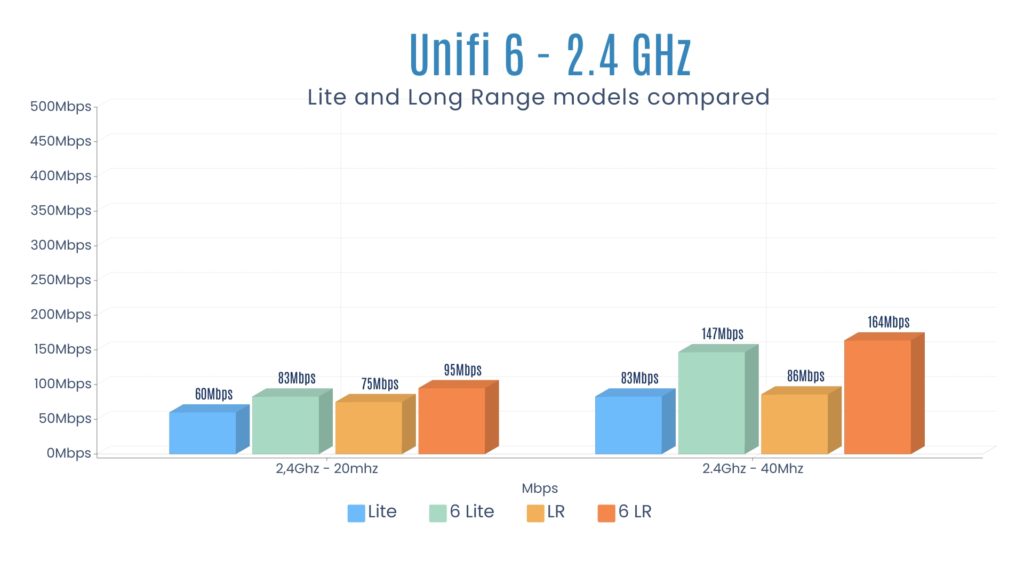
I have also measured the signal strength of the access points. From the dining table, I had a clear line of sight to the access point with a distance of approximately 7 meters. And from the garden, I had a 20cm brick wall and a glass door between it.
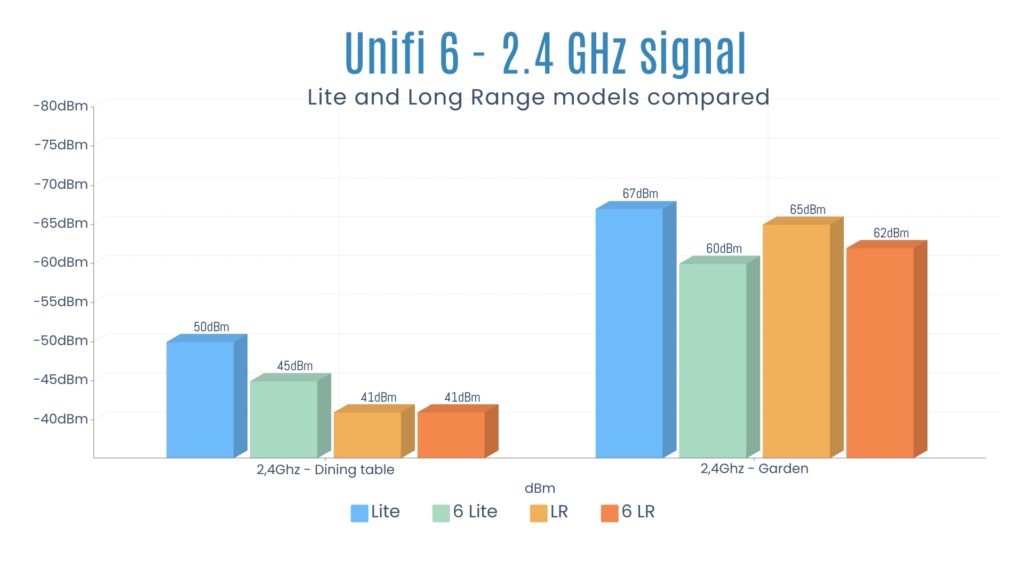
What I found interesting to see is that we can see a significant improvement between the Unifi 6 Lite and the old model. But between the U6 LR and the old Long Range model I didn’t.
Unifi 6 – 5Ghz performance
When it comes to speed improvement we can see the biggest difference in the 5 GHz band. You really see here the advantage of WiFi 6, with much higher throughput. For testing, I had set the transmit power to medium. The speed where lower on high, which is probably the result of being too close to the access point.
The 160 Mhz channel width is at the moment only supported on the U6 LR. In the chart below you won’t see the full potential of the 160 MHz channel width, due to the limitation of the 2×2 Wifi 6 adapter in my notebook. The advantage of the Unifi 6 Long Range with its 4×4 MU-MIMO 5 GHz radio really comes into play when connecting with multiple clients.
Also, keep in mind that the wider the channel the more interference you will get. Resulting in a less stable wireless network, with probably a higher latency. The 160MHz is in my opinion only useful if you work a lot with large files. Otherwise, stick to the 80MHz in less crowded areas or even 40MHz if the 5GHz band is already full with other wireless networks.
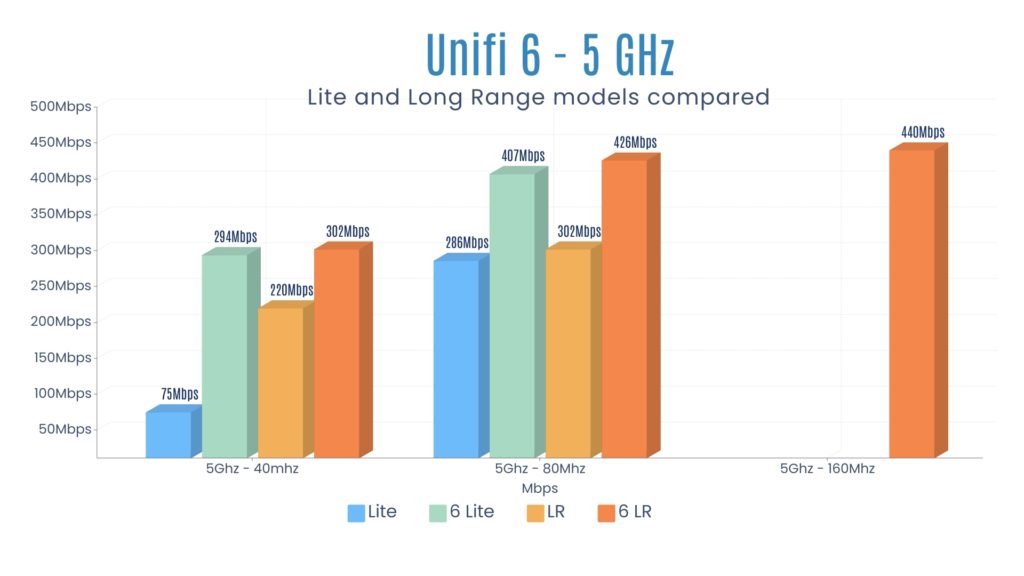
When we look at the signal strength we see again a great improvement between the lite models and only a minimal to no improvement between the long-range models.
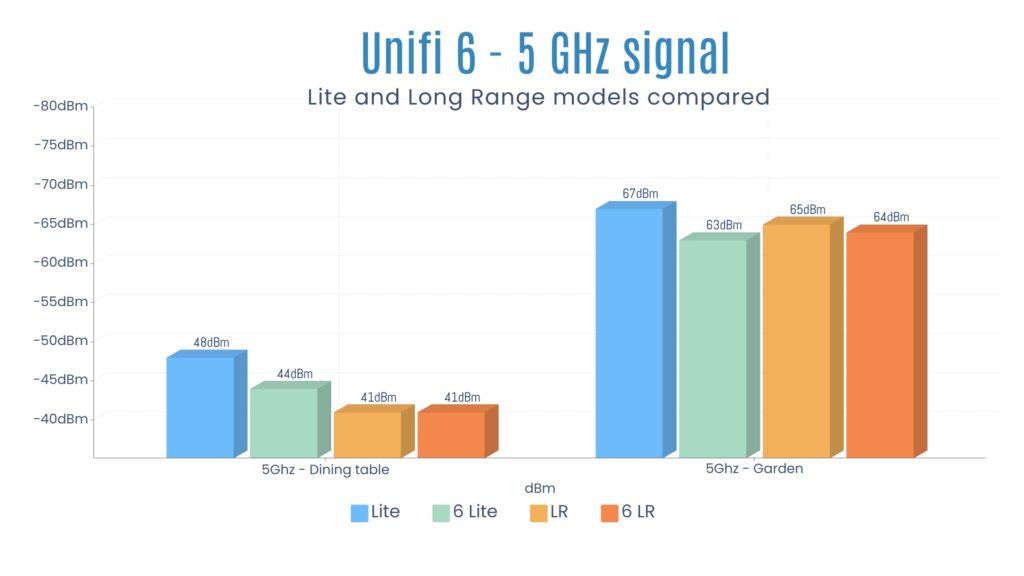
Unifi 6 Speed increase after replacing the access points
For the final test to compare the new Unifi Wifi 6 access points I measured before and after replacing the access points at the locations I use the wireless network the most.
On the ground floor, I have the Unifi 6 Long Range, which is mounted on the ceiling of our pantry. The panty is located roughly in the middle of the house (next to our stairs) and surrounded by sand-lime bricks. I measured it from the dining table, which is about 5 meters away on the other side of the wall. I also measured it from the kitchen, where we have a bar table. The kitchen is separated from the dining table with a 20cm thick brick wall.
Upstairs I have placed the U6 lite and measured the speed from my office. Between the access point and my office are two drywalls.
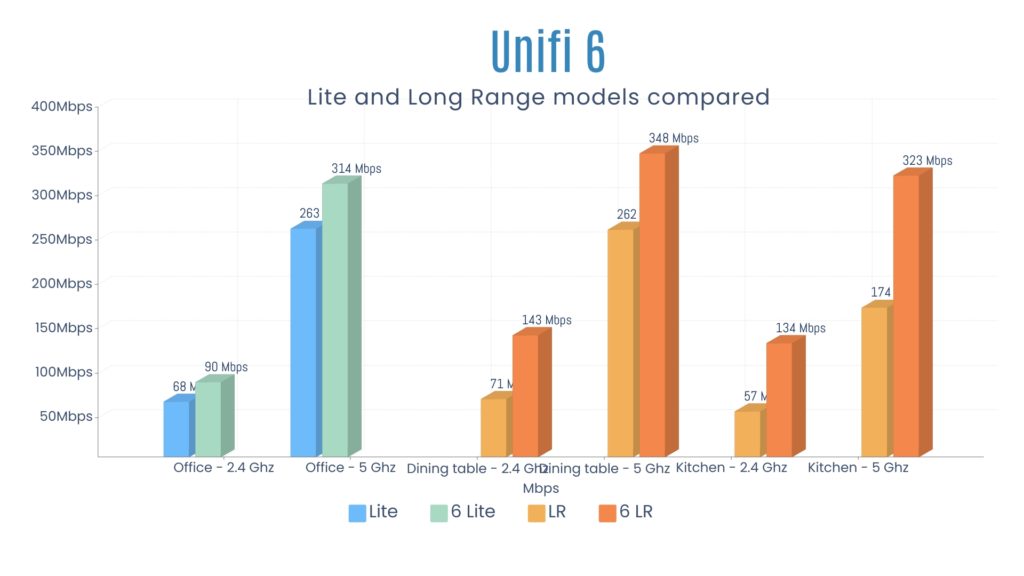
Here you can really see the performance improvement of the new U6 LR. The speedtest are done on 40Mhz for the 2.4Ghz band and 80Mhz for the 5Ghz band. The performance improvement of the U6 lite is between 20% and 30%.
For the Unifi 6 LR, we can see an almost 100% speed increase compared to the old long-range model.
Testing your own network speed
You can easily test your own wireless network with iPerf3, which you can download for free. You will need two computers for this, one notebook, of course, that can act as a client, and one computer or notebook that can be set up as a server.
For the best results, directly connect to the “server” to the same switch as the access points are connected on.
Download the latest version of iPerf on both compute and extract the zip file. On the server, open a command box or PowerShell and run iPerf in server mode:
iperf3 -s
Make sure you write down the IP Address of the computer that is running iPerf in server mode. To run a test you can run the following command on the client where you replace the IP Address wit the IP of the “server”:
iperf3 -c 192.168.1.10 -t 10
You can also run the test with multiple threads, which can increase the total speed that you can get, to do this use the -P switch:
iperf3 -c 192.168.1.10 -P 5 -t 10
Wrapping Up
For most home networks is the Unifi 6 lite the best choice, it’s fast enough, reasonable priced, and not too big. The nanoHD covers are really great when you need to place the access point in sight.
If you are looking for one access point that can cover your whole ground floor and part of your garden then the Unifi 6 LR is a good option. It’s quite big (and heavy), but as you can see in the tests, it has an amazing throughput, even through brick walls.
Again, keep in mind that these tests didn’t show the full potential of the access points. They are capable of even higher throughputs when using multiple clients (or multiple threads) or if you have a client with a WiFi 6 3×3 adapter, for example.
I just wanted to compare the old access points with the new Unifi WiFi 6 access points in a real-world scenario.
If you have any questions just drop a comment below.

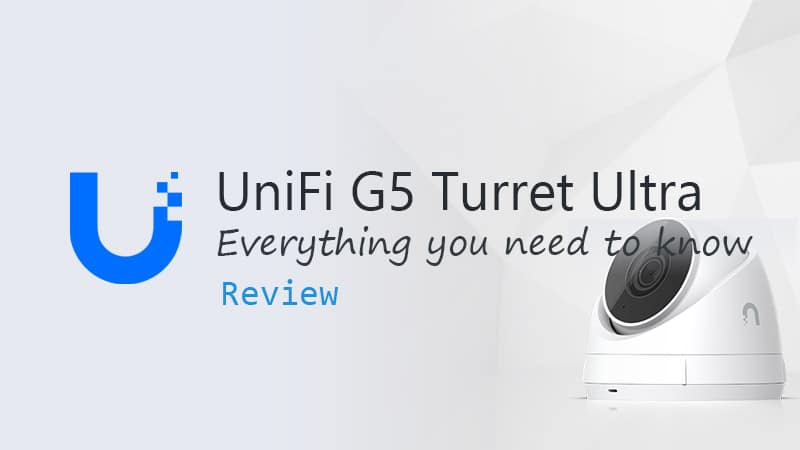



Currently have a AC-Pro in my living room and it had issues with coverage in my garage so I added a AC-M near the garage. I was considering the 6 LR as an upgrade and was wondering if the 6 LR could eliminate the AC-M.
That really depends on the distance and location of the access point. The 6LR is a bit strong, but not that much compared to the old LR for example. I don’t think you will see much improvement in the signal strength near your garage to be honoust.
Wondering if you set the site location to US…if you select Eu countries you will not get the full Tx power.
Can you please retest with US?
My 6lite if is set to Eu countries has under 20db TX even on high setting(26 beeing the max from spec sheet)….and is waay worse than a RT AC68U set to 26db both on 2.4 and 5ghz. Even in close proximity on wifi analyzer ac68u is better.
After i set it to Us.. 26db was reported and the situation improved…they are almost the same.
So us hard for me to belive that (from specs) a 6lite 26db Tx will do the same with a 6lr 30db Tx in range
From the signal strength graphs, it doesn’t seem the LR has a better signal than the Lite even in the 30 feet + 2 brick walls scenario. For 2×2 clients, might as well get the Lite. Agreed?
yes, the new 6 lite is amazingly strong.
Thanks for your review. Great job!
I am torn between a 6 Lite and a 6 LR for a bar area guest wifi. The room is about 25’x45′ with 12′ ceilings. I was going to place one of the AP’s in the center of the room to hopefully provide good signal to the 75 guests inside.
Am I better going two Lites at each end of the room or a LR in the center?
Thanks in advance!
One LR is better, with two lite’s in one open room the client will probably hop between the two. You could also try to get your hands on a 6 Pro. Harder to get, but is better at handling more clients simultaneously
I have 1 Meraki MR33 whose license is almost up. I have in on the second floor closer to 1 side of the house but still fairly center. I added this location recently during a renovation. I also added another 1 gang box by the 2 new bedrooms about 20ft away on the 2nd floor.
I also added a ceiling box on the 1st floor in the center of the house in kitchen area. Plus one in the Garage. I was doing the work so I ran cables to anywhere I thought I would want cameras or WAPS.
I wonder how much separation would be needed for two Lite WAPS. Would 20 feet be enough? My work is a University and they run Aruba APs for density and some are quite close together. But the Aruba controller is true Enterprise and better at management.
Just set the transmit power to low on both devices and you should be ok.
How is the 6 Lite mounted on a standard round ceiling junction box?
It comes with a mounting plate, that you can probably screw onto the junction box. But can attach it to any surface with proper screws and plugs.
Ruud, thanks for sharing your tests. Please kindly advise on my situation. We live in the U.S. in an L-shaped single-story, wood framed/drywall home. The current router/AP is a Orbi which I want to replace with a hard wired router/switch that will accept 5-6 wired devices (presently using 4) and add a Unifi 6 AP and am between the Lite and LR. The current Orbi is positioned at the “corner” of the L-Shaped floorplan on the floor. The bedrooms are located off one wing of the home with the furthest about 35-40 feet away from the AP. The family room is the furthest room on the other wing of the home, about 55 feet away. We have horrible cellular reception here and rely on WiFi. Probably 25 wifi clients in total connected to the network. I had a satellite Orbi connected to main Orbi but were getting constant dropouts so unplugged it. The stability improved greatly. Would you recommend the Lite or LR? What would be a good wired router/switch to use with the Unifi AP? I had previously tried an Edgerouter with the Orbi in AP model and could not get it working. I’ve since removed the wired router and am using the Orbi for both routing and AP. Thoughts on which Unifi AP and what type of wired router to use? Thank you ~ Mike
When possible, place two Lite‘s in the center of each wing of your home, that would give the best result. Otherwise, go for the LR.
For the switch, you could go for the USW-Lite-8-PoE and the EdgeRouter should be a good option. If you have the space and budget, then the Dream Machine Pro SE is the best option (replaces your router and switch)
I’m getting around 600Mbps stable download/upload on Wifi 6 Lite, 5GHz, 80MHz, terrible congestion (block of flats), and test path being:
pc ssd (smb) – rj45 – switch – rj45 – 6 lite – 5ghz wifi – intel ax200 – laptop ssd.
And even though the congestion is bad the connection is ultra stable, no link drops at all, while the router from isp was really struggling (which made me buy the ubiquity ap)
Thank you for the article, I’m curious if either the 6 lite or 6 lite LR can be installed on walls as compared to ceilings – and have the same coverage?
You can install them on walls, but then they won’t have the same coverage. The signal goes mostly sideways in a donut shape.
Hi Ruud, how about leaving the Lite on a TV console? Is it worse compared to mounting it on wall?
The problem with placing access points on or behind furniture is that you place them too low, blocking the wifi signal. For the best performance, you want a clear line of sight between your device and the access point. Walls will lower your signal strength, but other furniture, like cabinets, also.
So best is to place the access point high on a wall or ceiling. But you can always try it and measure the signal strength with the Wifi Man app from Ubiquiti.
Thanks for all your tests and info. You really helped me with your info and schematics on the Doorbell G4, and now this is another interesting article.
Good job!
I love UniFi APs. I already have 2 old LR APs, recently bought a new U6-LR to install on the second floor of my house and was pleasantly surprised than my S20+ could still pick-up decent WiFi 6 signal even outside with a multi-layered wall (which includes brick) between me and the AP.
The old LR were already impressive, but the new LR impresses me even more. It sure is big and heavy though.
So having the 2 pc’s of the old LR model, living in a small village with “plenty” off free wifi channels – Then there is no point in upgrading?
Only using it for home, with a few phones & IPads 🙂